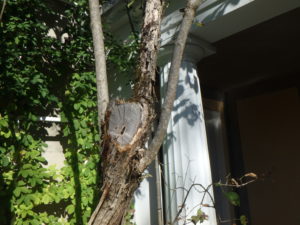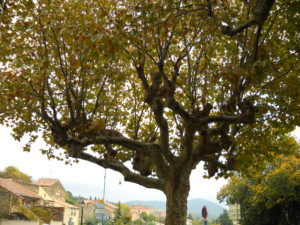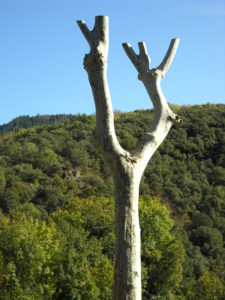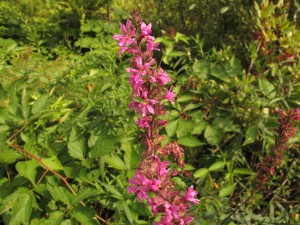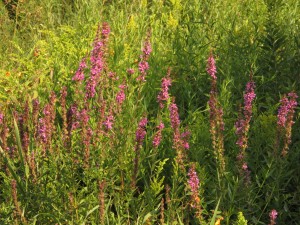Winter Pruning
This is a time of year when little is happening in the garden. Weeds either have been pulled, or won’t be – until next spring. I’ve cut back most flowers, both perennial and annual. The ground is starting to freeze and we’ve had some snow. It’s a good time to be lazy. But … I don’t like to be lazy.
So what can a gardener do? Prune. Trees and shrubs are dormant now, and it is fine to do some pruning. You can see the structure of deciduous woody plants easily now, as their leaves have dropped.
Before you start hacking away, be advised that shrubs that bloom in spring or early summer already have their flower buds ready and waiting for spring. So if you prune heavily, you will lose blossoms. On the other hand, if you have the time now and the plants need work, get to work.
In fact, most shrubs and fruit trees have both their leaf and flower buds. A few exceptions exist, of course: hydrangeas, summer sweet clethra, seven-sons flower tree, witchhazel and franklinia come to mind as woody plants that set their blossom buds on new wood in the spring for summer or fall blooming.
On a recent day I went out to do some radical pruning. I have a white lilac that had gotten too tall. It was 15 or 20 feet tall, and the blossoms were out of reach – and largely out of sight when blooming. It was like that when I bought my house, eons ago, and I cut it right to the ground back then, every bit of it. I didn’t care if it died. In fact I kind of hoped it would because it was so out of control. But the roots sent up new growth and if was a nice sized shrub a while. But life gets busy and all of a sudden it was too tall again. This time I was a bit more controlled.
I have been observing old lilacs to see what others have done with them, and how the plants have responded. At Saint Gaudens National Park I saw that the groundskeeper had cut back old lilacs to about 5 or 6 feet above ground, and that new branches had sprouted from dormant buds on those stems. I’m sure they looked pretty gawky for a year or two, but vigorous new growth had filled in. I decided to try the same.
So I cut back the lilacs, reducing their height to 4 to 6 feet. There will be no blossoms this year, and probably not next year. But there are a few root sprouts that have stems an inch thick, and those may produce blossoms. I just have to make sure those stems don’t reach for the sky.
You might wonder why my lilacs have gotten so tall. I think the answer is that they don’t get enough sunshine. There is a row of sugar maples only about 25 feet away from them, and these create more shade on my lilacs every year. Plants tend to grow tall and lanky if they are sunshine-deprived. They reach for the sun.
Elsewhere on my property that day I cut back my seven sons flower tree (Heptacodium miconiodes). This is a very vigorous fall-blooming tree I’ve had for 15 years or more. It can grow a shoot 6 feet in a year, once established. It is within eight feet of my house, and some of the branches were acting like voyeurs, trying to peak in my bedroom window. They needed some attention.
On one 10-foot stem I cut off all the branches. I am experimenting with a pruning technique called pollarding. This technique is commonly employed with English plane trees in Europe, and I like the look. Every few years trees are cut back to their trunks. The branch locations get scarred, and develop big lumps that then produce multiple new, vigorous branches.
Pollarding is particularly good for fast growing, weak-wooded trees. If those English plane trees were not cut back from time to time, the branches would likely break off from their own weight. That would be dangerous, as they are commonly planted along town streets and in parks. They are great shade trees.
I wouldn’t recommend cutting off all limbs on a tree and leaving just the trunk until you have tried pollarding part of the tree to see how it responds. I have read, for example, that one can pollard maples, oaks and beeches, but I wonder if they would perform well. They don’t grow as fast as some trees, and might take too long to develop an interesting appearance. Or try pollarding a small tree in a not-so prominent place to see how it does.
Fruit trees are most often pruned in late winter or early spring, but you can prune them now if you wish. We have some snow now, which makes ladder work more difficult, but a well-pruned apple tree can be a pleasant sight all winter. So have at it!
Henry’s gardening books are available from his website, www.Gardening-Guy.com. You may read his blog posts at https://dailyuv.com/
Dealing with Invasives
I’m sure you know purple loosestrife, even if you don’t know its name. It’s a big, tall clumping plant bearing bright pinkish-purple flowers and it’s appearing now in your neighborhood, especially in wet areas. What you may not know is that it’s an aggressive foreign invader that can out-compete many of our native species. It has been around for a couple of centuries – it came over, allegedly, in soil used as ballast in sailing vessels in the late 1700’s.
But if it grows well and it’s pretty, what’s the problem, you may wonder? A number of things. It’s a big plant that can dominate the landscape and shade out smaller, less vigorous native plants. A mature loosestrife can produce up to a million seeds, seeds that can be carried by streams to new locations. Wildlife can be negatively impacted. Many insects and birds depend on native plants for food and nesting materials- native plants that evolved with them. Invasives like purple loosestrife often do not meet their needs.
According to Barbara McIlroy of Etna, NH, who has been active in the movement to control invasive species, the number of bird and butterfly species present on properties that grow native species is much, much higher. “I’m converted,” she told me. “Grow natives. Period. The positive effect on the wildlife is dramatic.”
Unfortunately, it’s almost impossible to rid your property of purple loosestrife. These plants have amazingly tenacious roots. Before I knew better I tried digging out some large plants from a swampy area on my property. Yes, I got the plants out – but some of the roots broke off and re-sprouted. And by clearing out a space, I also opened up a new site for seeds to grow. If you have had purple loosestrife in the past, there are seeds waiting for a chance to germinate – like little time bombs.
But there is good news: two species of beetle (Galerucella calmariensis and G. pusilla) have been approved for and found effective in controlling purple loosestrife. These beetles cannot eliminate the loosestrife, but can reduce the numbers dramatically. Loosestrife is not a problem in Europe the way it is here, in part because it has natural enemies – the beetles. By introducing the beetles, an effort has been made to help Mother Nature keep loosestrife under control. Once established, they eat enough of the leaves and stems that the plants do not bloom. And theses beetles have been well tested: they will not eat your garden plants or valuable crops.
In 2001 Saint-Gaudens National Historic Site in Cornish, NH released two species of beetles to see if they could control the purple loosestrife that was taking over the wetlands at Blow-Me-Down pond. I met recently with Steve Walasewcz, who monitored the effort from 2001 to 2008. He explained that the beetles did not have an immediate effect. In fact, from 5.75 stems per square meter in 2001, the numbers increased to 10.5 by 2003. But then they declined each year until reaching only 1.05 in 2008 – a tenth the number of stems.
I went to the area where the beetles were released in 2001 and although there were a few blooming stems of purple loosestrife, there were very few. According to a report done for Saint-Gaudens NHS, it is believed that even low numbers of beetles prevent flowering; at higher numbers, “the beetles can strip the plants of its photosynthetic layer, resulting in high mortality in the winter due to a depleted starch reserve.”
Unfortunately, the beetles are not readily available for purchase. But for several years I have been experimenting with my own way of controlling the problem near my brook. Each year in early July I take pruners and cut back the plants to the ground. I identify them by their square stems that have a reddish color near the ground, and of course their leaves. Then a month later, I do it again – in essence, acting like a beetle. By cutting back the plants, few are able to bloom, greatly reducing the number of seeds spilling into my environment.
As a second step, I planted some big, tall native plants that I hoped would compete with the purple loosestrife: Joe Pye weed (Eupatorium purpureum) and Canadian burnet (Sanguisorba canadensis). I also added marsh marigold (Caltha palustris), which though not tall, is tough. These natives have given purple loosestrife a run for its money. Instead of filling 3 wheelbarrows with cut loosestrife in early July, I was able to get it all in one.
Purple loosestrife is just one of many invasive plants. If you see a new, vigorous plant show up on your property, try to learn its name and find out if it’s a problem elsewhere. Meanwhile, there is good news: scientists are working on biological controls for both Japanese knotweed (commonly called bamboo) and garlic mustard. In England, certain beetles are now well established to reduce the vigor of Japanese knotweed.
Henry Homeyer is the author of 4 gardening books and a new children’s fantasy-adventure about a boy and a cougar. His web site is www.Gardening-guy.com.



